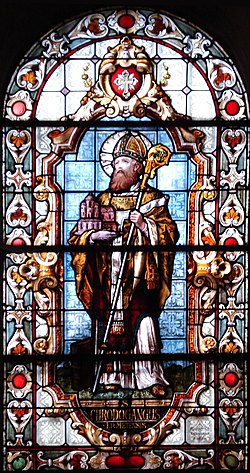According to M.A. Claussen, "Chrodegang's work lay at the foundation of the Carolingian spiritual revival of later eighth and ninth centuries." [5] In 748 he founded Gorze Abbey (near Metz). [6] He also established St. Peter's Abbey on the Moselle, and did much for the abbeys of Gengenbach and Lorsch. For the latter he is said to have obtained the relics of Saint Nazarius, and for Gorze those of Saint Gorgonius. In his diocese he introduced the Roman Liturgy and musical chant, and also enriched community life for the canons of his cathedral.
Rule of Chrodegang
Around 755, he wrote a special rule for them, the Regula Canonicorum, later known as 'Rule of Chrodegang'. [7] The rule, containing thirty-four chapters, was based on the Rule of St. Benedict. Its purpose, however, was principally pastoral: to encourage the mutual support of a community as found in a monastic setting, while recognizing the very different responsibilities of canons serving the spiritual needs of the faithful. [8] Chrodegang necessarily adapted the Benedictine rule, particularly in regards to the hospitality characteristic of monasteries, and the care of the sick as there were neither guest houses nor hospices at cathedrals. [9]
The rule was widely circulated and gave an important impulse to the spread of community life among the secular clergy. In 816, it was incorporated in part into the Institutio canonicorum Aquisgranensis established by the Council of Aachen. [10] By the eleventh and twelfth centuries, the Rule of Chrodegang was gradually supplanted by more popular rules based on Augustine. [11]
It seems probable that the Rule of Chrodegang was brought by Irish monks to their native land from the monasteries of north-eastern Gaul, and that Irish anchorites originally unfettered by the rules of the cloister bound themselves by it. The Rule of Céli Dé, which is preserved in the Leabhar Breac, and has been attributed to Máel Ruain, was possibly written in the 9th century by one of his community. [12] The Rule "...is more a canonical than a monastic rule, and analogous to Chrodegang of Metz's Regula Canonicorum." [13]
In the course of the 9th century mention is made of nine places in Ireland (including Armagh, Clonmacnoise, Clones, Devenish and Sligo) where communities of Culdees were established as a kind of annex to the regular monastic institutions. They seem especially to have had the care of the poor and the sick, and were interested in the musical part of worship.
